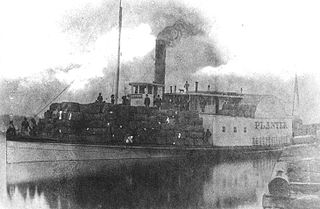 W
WThis is a list of ships of the Confederate States Navy (CSN), used by the Confederate States of America during the American Civil War between 1861 and 1865. Included are some types of civilian vessels, such as blockade runners, steamboats, and privateers which contributed to the war efforts by the CSN. Also included are special types of floating batteries and harbor defense craft.
 W
WCSS Fanny was a small propeller-driven steam tug used by the Confederate States Navy to defend the sounds of northeastern North Carolina in the American Civil War. Originally armed as a gunboat and operated by the Union, she was captured in October 1861 by the Confederate Navy, and later lost at the Battle of Elizabeth City in February 1862. Due to being used as an observation balloon platform, Fanny is sometimes credited with being the first self-propelled aircraft carrier.
 W
WCSS George Page, a 410-ton sidewheel steamship, was originally built as a transport at Washington, D.C. in 1853.
 W
WHarriet Lane was a revenue cutter of the United States Revenue Cutter Service and, on the outbreak of the American Civil War, a ship of the United States Navy and later Confederate States Navy. The craft was named after the niece of senator and later United States President, James Buchanan; during his presidency, she acted as First Lady. The cutter was christened and entered the water for the Revenue Service in 1859 out of New York City, and saw action during the Civil War at Fort Sumter, New Orleans, Galveston, Texas, and Virginia Point. The Confederates captured her in 1863, whereupon she was converted to mercantile service. Union forces recaptured her at the end of war. The US Navy declared her unfit for service and sold her. New owners out of Philadelphia renamed her Elliot Ritchie. Her crew abandoned her at sea in 1881.
 W
WUSS Isaac Smith was a screw steamer acquired by the United States Navy during the American Civil War. She was used by the Union Navy to patrol navigable waterways of the Confederate States of America to prevent the Confederacy from trading with other countries. In 1863, she became the only warship in the American Civil War to be captured by enemy land forces. She then served in the Confederate States Navy as CSS Stono until she was wrecked.
 W
WCSS Jamestown, originally a side-wheel, passenger steamer, was built at New York City in 1853, and seized at Richmond, Virginia in 1861 for the Virginia Navy during the early days of the American Civil War. She was commissioned by the Confederate States Navy (CSN) the following July, and renamed CSS Thomas Jefferson but was generally referred to as Jamestown, after Jamestown, Virginia.
 W
WUSS Planter (1862) was a steamer taken over by Robert Smalls, a Southern slave and ship's pilot who steered the ship past Confederate defenses and surrendered it to Union Navy forces on 13 May 1862 during the American Civil War. The episode is missing from Scharf's History of the Confederate States Navy, except for one sentence saying that Smalls "stole" the ship.
 W
WUSS Red Rover (1861) was a 650-ton Confederate States of America steamer that the United States Navy captured. After refitting the vessel, the Union used it as a hospital ship during the American Civil War.
 W
WCSS Sea Bird was a sidewheel steamer in the Confederate States Navy.
 W
WStar of the West was an American civilian steamship that was launched in 1852 and scuttled by Confederate forces in 1863. In January 1861, the ship was hired by the government of the United States to transport military supplies and reinforcements to the U.S. military garrison of Fort Sumter. A battery on Morris Island, South Carolina handled by cadets from the South Carolina Military Academy fired upon the ship, effectively the first shots fired in the American Civil War.
 W
WUSS United States was a wooden-hulled, three-masted heavy frigate of the United States Navy and the first of the six original frigates authorized for construction by the Naval Act of 1794. The name "United States" was among ten names submitted to President George Washington by Secretary of War Timothy Pickering in March of 1795 for the frigates that were to be constructed. Joshua Humphreys designed the frigates to be the young Navy's capital ships, and so United States and her sisters were larger and more heavily armed and built than standard frigates of the period. She was built at Humphrey's shipyard in Philadelphia, Pennsylvania and launched on 10 May 1797 and immediately began duties with the newly formed United States Navy protecting American merchant shipping during the Quasi-War with France.